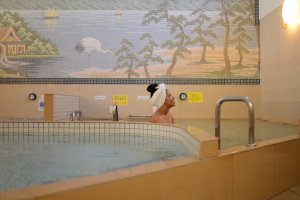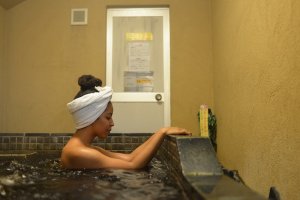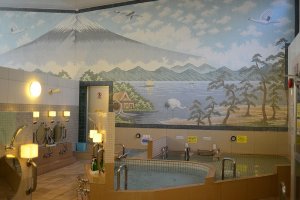Public bathing in Japan was once a necessity and an important part of the culture and community. This was particularly true during the Showa Era (1926 – 1989) when the sento had its heyday and more than 2000 sento existed across Tokyo. A sento is a public bathhouse that is typically family-owned. However, since most homes around Japan these days include a bathtub, the number of sento has been on a steady decrease with only around 600 sento left in the capital.
Recently I learned that Ota City, one of Tokyo’s 23 districts, is known to have the largest number of sento, each with its own unique charm. Since I am quite a fan of sento, I went to explore a few of them. The city government sets the price of all sento, which is 460 yen for ages 12 and over. Make sure to bring a towel, body soap, shampoo, and conditioner, as it is usually not provided. However, those items can be purchased at the reception if you happen to be without.
The website Ota1010 is a great place to start searching for the perfect sento. It includes contact and access information of all the sento in the area as well as guidance on how to make the most of your time at the sento, while avoiding any faux pas.
I found three sento that I set out to explore in one afternoon.
Kugahara Yu

Kugahara Yu has a very welcoming feel to it as soon as you walk through the door. The reception area is small and modest, but the staff is pleasant and very accommodating. I immediately felt at home, as if I was one of the locals. The changing area has a standard set up of lockers, a few benches, a sink area with vanity mirror, and a vending machine.
The hidden gem of this place though lies in the bathing area, where you will find the awe-inspiring mosaic-tiled mural of Japan’s beloved Mt. Fuji adorning the wall. The bathing area is large and baths are plentiful, including a black water natural hot spring bath, rich in minerals to help relieve stress and alleviate skin problems. As an added bonus, they also have a steam room and dry sauna.
Fuku no Yu

Recently renovated and reopened in 2016, Fuku no Yu is a modern style sento with clean and minimal design. Inside the changing room they even offer complimentary chilled barley tea, which is nice to have before and/or after the bath.
In the bathing area, while there are plenty of shower spaces, there are only two bath options. One is a traditional sitting bath and the other one is a stone bath. With only two baths it’s quite compact, but still very relaxing and enjoyable.
The biggest perk of this sento is the freshly baked pizza that is made by the owner’s son. This is quite a rare treat, which for now is only sold on the weekends, but it was nice to be able to enjoy a delicious pizza and with a draft beer after a good soak.
Kotobuki Yu
Kotobuki Yu is easily recognizable by a tall and narrow smoke stack on the side of the building and the coin laundry next door. The building style is reminiscent of the Showa period and it’s especially noticeable when entering the changing room, which has quite a few nostalgic pieces sitting around.
In most sento you will find the baths located alongside the walls of the bathing area. However, here, the layout is a bit different with one large round tub located in the middle of the room.
The round tub is separated into several smaller baths. Some have normal heated water, some with jets, and there are also a couple of ‘special attraction’ baths like an electric bath and an extreme hot water bath that can reach up to 46 degrees Celsius (114 degrees Fahrenheit). The electric bath could take some getting used to, but is said to have special health benefits such as relief for stiff shoulders and back pain.
Since people don’t visit sento much compared with back in the Showa period, many of the remaining establishments are looking to reinvent themselves. They are interested in not only attracting new customers, like international visitors looking for a quintessential Japanese cultural experience, but also looking at ways to keep the local residents coming back by offering perks they cannot get from their own home bathing experience.





































